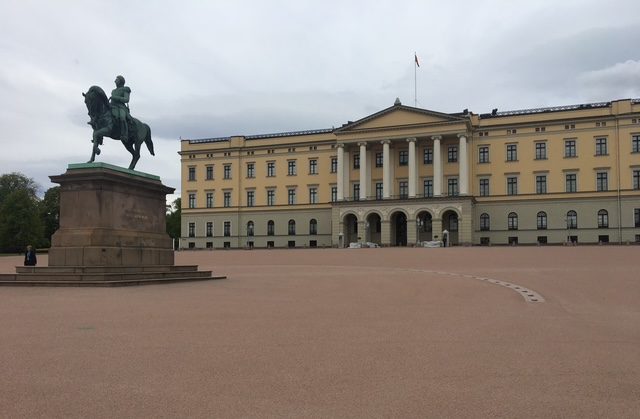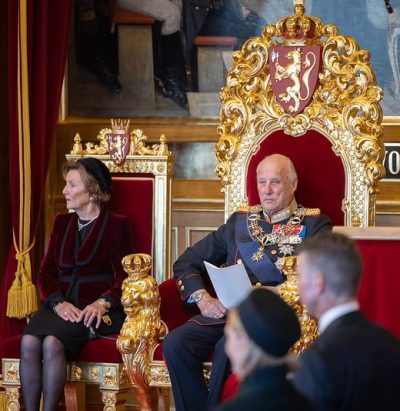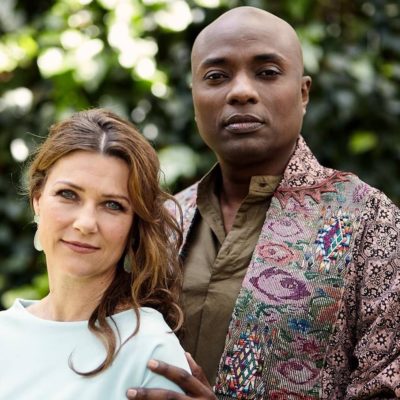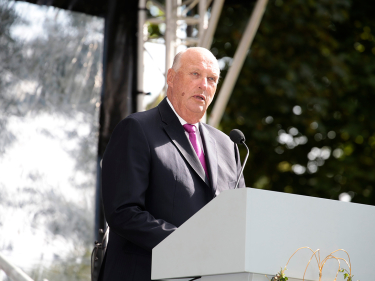NEWS ANALYSIS: A verbal assault on Norway’s King Harald V, broadcast internationally by his new American son-in-law Durek Verrett, has set off public uproar among Norwegians. Protests have come from both monarchists and those favouring a republic, and set off calls for the king to strip Verrett’s wife, Princess Martha Louise, of her royal title.
 There’s been lots of drama going on behind the walls of the Royal Palace in Oslo following the release of a new internationally available documentary involving Norway’s Princess Martha Louise and her new American husband. PHOTO: NewsinEnglish.no/Morten Møst
There’s been lots of drama going on behind the walls of the Royal Palace in Oslo following the release of a new internationally available documentary involving Norway’s Princess Martha Louise and her new American husband. PHOTO: NewsinEnglish.no/Morten Møst
It’s been an unusually rough week for Norway’s otherwise popular royal family. Not only did Verrett, in a new Neftlix documentary, unleash a litany of complaints about his entry into the family, his wife nodded as he spoke and seemed to condone them. Then came news that Crown Princess Mette-Marit, already dealing with the criminal drama around her son, will be heading off on sick leave again in connection with her chronic lung disease. That came amidst reports that her son’s upcoming trial on charges of rape, vandalism and other forms of violence may be carried out behind closed doors, out of consideration to his alleged victims.
 King Harald and Queen Sonja at the opening of Parliament in 2023. PHOTO: Stortinget/Morten Brakestad
King Harald and Queen Sonja at the opening of Parliament in 2023. PHOTO: Stortinget/Morten Brakestad
Norwegians could only wonder how all of this is affecting the 88-year-old King Harald and Queen Sonja, also 88. The king carried on with official duties on Sunday, appearing at the 850-year anniversary of Nesodden Church just across the fjord from Oslo, but he refused to take any questions.
There’s also been little specific response from the Royal Palace to Verrett’s allegations that neither the king, the queen nor Crown Prince Haakon “knew what racism is” when he first met the family in 2019. Verrett, a self-professed shaman and alternative healer who married Martha Louise last year, has been subjected to racial comments on social media and complains in the new Netflix documentary that no one in the royal family helped him find his place.
 Durek Verrett and Princess Martha Louise in 2019. PHOTO: Facebook
Durek Verrett and Princess Martha Louise in 2019. PHOTO: Facebook
King Harald has referred to various criticism of Verrett as being tied to a “culture clash,” but Verrett claims that didn’t help him or satisfy his professed needs for assistance in adapting to life in Norway. Martha Louise had told him to “just be yourself,” Verrett says in the documentary, but that didn’t help. When he turned up at the palace in Oslo to meet the royal couple, wearing a kimono and cowboy boots, he claims the royal couple simply stared at him. “They didn’t like my clothes,” he says in the documentary.
What Netflix doesn’t report is how King Harald and Queen Sonja have for years been advocates of openness, acceptance of and assistance for immigrants, and pride in the multicultural society that Norway has become over the past several decades. King Harald was a war refugee himself, growing up in exile in the US while Norway was occupied by Nazi German forces. He has officially apologized to various ethnic- and minority groups in Norway for poor treatment they have received, he has attended religious events in both synagogues and mosques, and both he and Queen Sonja have visited many asylum centers and other organizations for the disadvantaged.
King Harald is perhaps best known, however, for a speech he delivered on the occasion of his 25th year as Norway’s monarch in 2016. In it, he shattered the stereotype of Norwegian ethnicity, stressing instead how many Norwegians now have multi-cultural heritage, various ethnic and religious background and sexual orientation. None of that came out in the Netflix documentary, which many Norwegians have branded as lacking any historical perspective.
 The king’s speech in 2016, when he stressed the value of Norway’s diversity, endeared himself to hundreds of thousands of Norwegians, especially what his father called “new Norwegians.” PHOTO: Det kongelige hoff/Sven Gjeruldsen
The king’s speech in 2016, when he stressed the value of Norway’s diversity, endeared himself to hundreds of thousands of Norwegians, especially what his father called “new Norwegians.” PHOTO: Det kongelige hoff/Sven Gjeruldsen
The king’s speech at the time also endeared him to the thousands of Norwegians who were born outside of Norway or whose parents were. They were rushing to his defense this past week, especially during Norwegian Broadcasting (NRK)’s national broadcast debate program Debatten. “There are few people I’ve met who are more inclusive than King Harald and Queen Sonja,” said Abid Raja, an author, lawyer and Member of Parliament for the Liberal Party whose family comes from Pakistan. He was clearly furious with Verrett’s complaints about King Harald, urging him to “shape up” and “join the battle against racism that’s real.” Raja went on to scold Verrett for not being better informed about his own in-laws and what they’ve done to promote integration and inclusion: “Stop putting down our king!”
Many other leaders of various affirmative action groups also raved about King Harald and how much he’s done to advance integration and bring people together in Norway. Umar Ashraf, leader of the Anti-racism Center in Oslo, noted that King Harald has taken the challenges of ethnic diversity seriously “to the highest degree,” while Aili Keskitalo, former president of the Sami Parliament in Northern Norway, spoke of how King Harald has engaged himself in Sami issues. He also invited Sami demonstrators, for example, to a meeting at the Royal Palace after they’d been protesting in the streets of Oslo for days on end over the government’s failure to recognize their objections to wind turbines in reindeer grazing areas.
Netflix didn’t mention the reasons for much of the criticism of Verrett, for example when he claimed that a medallion he sells on his website helped him recover from Covid, and the controversy that arose over some of his views on cancer causes and treatment. There was no mention of how several health-related organizations in Norway no longer wanted to have ties to Princess Martha Louise, because of conflicts with her own alternative approach to health issues. Verrett and Martha Louise both complained so much in the documentary that critics have charged them with taking on the roles of victims despite all the privileges they’ve enjoyed because of her position in the royal family.
It was Verrett, meanwhile, who claims to have wanted a big “royal wedding” last year, to which the couple sold photo rights to the celebrity magazine Hello! and to Netflix, and banned both Norwegian and international media from taking their own photos or attending the wedding ceremony. That clearly disturbed King Harald, who responded by disallowing any photos of royal family members from being taken by Hello! or Netflix at the wedding if the rest of the media wasn’t allowed the same access.
Last week, after the documentary was released, the Royal Palace also issued a statement contending that the Netflix documentary itself violated an agreement reached between the couple and Kongehuset (the king, his family and staff) in November 2022. It was aimed at preventing Princess Martha Louise and Derek Verrett from exploiting her royal title for commercial gain, which she’d been repeatedly accused of doing for many years, also before she met Verrett.
Now King Harald and palace staff claim his daugher and son-in-law have violated their joint agreement, once again. “Everyone has the right to tell their own history,” the palace wrote after the Netflix documentary was released. “That also applies to Princess Martha Louise and Durek Verrett. At the same time, the Royal Palace wants clearer lines between Princess Martha Louise’s and Durek Verrett’s activities and the palace. That will be the theme of conversations we will continue to have.” The king himself has said on national TV in Norway that the monarchy “is not up for sale.”
The only way to enforce the agreement, claim many Norwegian commentators, is for the king to revoke Martha Louise’s “princess” title. Norway’s largest newspaper, Aftenposten, was among several editorializing this week in favor of removing her royal title. The newspaper called the Netflix documentary itself “an embarrassment of a film” that has unfairly affected both King Harald and Queen Sonja. Worse than that, Aftenposten wrote, is the new violation of the palace’s agreement with Martha Louise and Verrett. Several other newspapers on both ends of the political spectrum in Norway wrote the same, with the left-wing Dagsavisen’s headline reading: “Don’t mess with the king.”
Norway’s constitution, notes Aftenposten, “puts clear limits on what the monarch can do in such cases,” when he or she needs to exert authority and “defend the integrity of the Royal Palace.” Only the monarch can take away a royal title and should do so in Martha Louise’s case, wrote the paper. A recent survey published in newspaper VG indicates that fully 70 percent of Norwegians agree.
Martha Louise and Verrett were restrained in their reaction to all the public anger vented at them in Norway. They stressed that neither of them acted as executive producers for the documentary and claimed that its “final editing and direction” was only “in the hands” of its director Rebecca Chaiklin and Netlix itself. The couple thus seem to blame Chaiklin for all the fuss, noting that “the film reflects Rebecca’s history, told from her perspective.”
The couple acknowledged “the seriousness of this situation” and the “importance of maintaining the integrity of the (commercial) agreement (with the palace) moving forward.” In hindsight, they admitted, “there’s no doubt we wish that had handled things differently. Our focus is now to take responsibility and make sure we move forward in a constructive manner.”
They further claimed to have “close and loving relationships with every single member of the Royal Family. We care deeply about them and it pains us if someone in this process has been hurt or injured in any way. At the same time we think everyone does have a right to tell their own story and that applies to us, too. It would have been impossible to make a documentary without acknowledging that Martha Louise is a mamber of the Royal Family. Rebecca Chaiklin chose her own angle: to share our love story. We are grateful for having had the opportunity to work with her and with Netflix to bring this story to life.”
Verrett has also written an apology of sorts on social media in which he once again appears to contradict himself by writing that “I don’t think they (the king and queen) didn’t know that racism exists,” instead that they didn’t realize how it has affected him. He claimed that he just doesn’t think Norwegians understand him, adding that he doesn’t view himself as a victim at all.
Others aren’t convinced, including several so-called “experts” on the royal family. “Those sitting with the losing cards in all this are the monarchy and the (people at) Royal Palace,” Tove Taalesen, an author and journalist at Nettavisen in Oslo. “It’s sad that the king has had to go through all this. It’s sad that this is the way the Norwegian monarchy is being presented to the world.”
NewsinEnglish.no/Nina Berglund